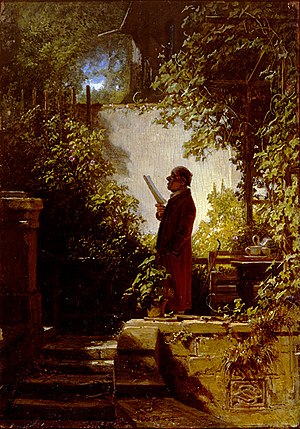Newspaper reader in the house garden

|
| Newspaper reader in the house garden (the morning reading) |
|---|
| Carl Spitzweg , around 1845/1858 |
| oil on wood |
| 21.3 x 15.5 cm |
| Museum Pfalzgalerie, Kaiserslautern |
Newspaper reader in the garden , also called The Morning Reading , is a small oil painting by Carl Spitzweg . It is now in the Museum Pfalzgalerie Kaiserslautern . The dating of the painting is not entirely certain. It was created between 1845 and 1858. The signature Carl Spitzweg, an S in a rhombus , is located in the front right of the masonry.
Image content
A newspaper reader dressed in a dark red dressing gown has retired to his secluded garden area. A high, sunlit wall separates his garden from that of the neighboring property. On the left of the wall there is a trellis that is densely overgrown with clematis . Further in front of the picture on the right side is an arbor that is covered with wine. She arches over a table on which the breakfast dishes are . The long tobacco pipe is leaning against the bench.
The newspaper reader stands out against the brightly lit wall. The eyebrows are raised, the lower jaw is slightly pushed forward, as if disapproving of what he is reading in the newspaper he is holding. The dressing gown and coffee dishes identify the newspaper reader as a wealthy citizen. When the picture was taken, coffee was still a drink for wealthy citizens.
background
The picture seems predominantly idyllic to today's viewer. Against the historical background of the revolution of 1848 , however, this picture also offers a critical statement. The revolutions of 1848/49 are the uprisings and bourgeois revolutionary uprisings against the ruling powers of the Restoration and their political and social structures in several countries in Central Europe . The initial spark of the unrest was, among other things, the French February Revolution of 1848 and the proclamation of the Second French Republic . In individual regions, events escalated to interstate wars (in northern Italy in the first Italian War of Independence and in Holstein / Schleswig / Denmark in the first Schleswig-Holstein War ), or took on civil war-like proportions (e.g. Vienna: October 1848 , during the Imperial constitution campaign in Baden: May to July 1849 , Saxony: May 1849 or the Palatinate: May / June 1849 , and in Hungary: March to October 1849 ). The surveys were of different intensity and duration in the respective states and regions. In October 1849 at the latest, the last revolutionary struggles ended with the final surrender of the Hungarian independence movement of that time.
The suppression of the uprisings went hand in hand with extensive restrictions on civil rights. Newspapers and reading societies were banned or only published under strict censorship . Even smoking in public places and streets was prohibited. In view of the troubled times of the German pre-March it was advisable for the individual citizen not to express himself politically. Retreating into private space alone offered the opportunity to protect oneself from censorship. Unobserved and far from society, the newspaper reader can at least express his disapproval by miming what is in the newspaper. Silke Friedrich Sander describes the newspaper reader who indulges in his cozy vice in the garden as a system critic, even as an anarchist in a dressing gown. During this time, however, the reputation of newspaper readers themselves was also called into question.
literature
- Sabine Schulze (Ed.): Gardens: Order - Inspiration - Luck , Städelsches Kunstinstitut , Frankfurt am Main & Hatje Cantz Verlag, Ostfildern 2006, ISBN 978-3-7757-1870-7 .
- The Metropolitan Museum of Art: German Masters of the Nineteenth Century: Paintings and Drawings from the Federal Republic of Germany , Harry N. Abrams, New York 1981, ISBN 0-87099-263-5 .
Individual evidence
- ↑ a b Silke Friedrich Sander in Schulze et al., P. 162.
- ↑ Marc Reichwein: Yesterday's newspaper philistine as today's digital bohemian . In: Der Umblatter , April 16, 2010.